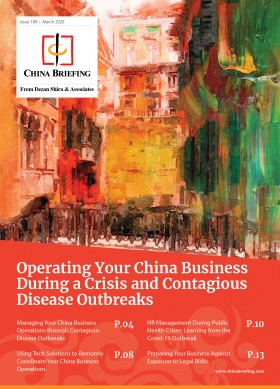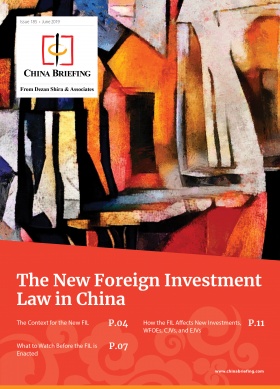Why China Could Lead the Global Economic Recovery After COVID-19
With the global economy in turmoil due to the COVID-19 coronavirus pandemic, China is in a unique position to lead the subsequent recovery.
Like other countries hit by COVID-19, China’s economy suffered greatly over the course of the outbreak. China’s GDP contracted by 6.8 percent year-on-year during the January-March period, including an enormous 39.2 percent drop in Hubei province, the epicenter of the outbreak.
Now, however, China has largely gotten COVID-19 under control and the economy has mostly re-opened, at a time when much of the rest of the world is facing the worst of the virus. While many governments are in crisis management, the Chinese government is now looking ahead towards putting the economy back on track for the rest of 2020 and beyond.
Due to the size of China’s economy, its success will be instrumental in revitalizing the global economy as a whole – and with the virus under control and ambitious economic policies set to be released, China appears well-positioned to accomplish just that.
Coronavirus under control in China
China has successfully gotten the spread of COVID-19 mostly under control, and compared to other major economies, is well equipped to identify and isolate new cases that may emerge in the future.
After the virus first emerged in late 2019, the outbreak spread rapidly in January and early February, at which point the vast majority of global COVID-19 cases were located in China. However, once the government recognized the virus, it responded with strong measures to curtail its spread.
Through mass testing, the aggressive use of quarantines and physical distancing, and the adoption of technology to track the spread of the virus, Chinese authorities managed to control the virus. Total reported cases stabilized at just over 80,000 in late February and there are now fewer than 1,000 active cases.
As a result of China’s success in managing the virus, most businesses have reopened – including in Wuhan, the city at the center of the outbreak. Manufacturing in China, for example, is back up – to about 80 percent of usual levels – as factories reopen and workers emerge from isolation.
Although a rebound of COVID-19 will be a concern until a vaccine is developed, the infrastructure China has already put in place to manage the outbreak will empower authorities to isolate new outbreaks. Chinese authorities, for instance, have instituted virus tests in workplaces, schools, and elsewhere, and launched a smartphone app to track users’ health status. Such measures will allow authorities to respond quickly to new COVID-19 cases, as recently occurred in the northeast province of Heilongjiang, which borders Russia – a new coronavirus hotspot.
In contrast to China, several other major economies are now facing the worst of the virus, and the strategies that some governments are employing may prolong the spread.
In the US, for example, COVID-19 spread in earnest in March, and there are now already over a million cases in the country. Although the spread of the virus in the US is far from under control, some states have already begun partially lifting their lockdowns and others are planning on following. Such measures will likely lead to the continued spread of the virus, meaning that the worst of the outbreak in the US will almost certainly last significantly longer than it did in China.
Ambitious economic policies forthcoming
Although COVID-19 sullied some of China’s short-term economic goals, the government still has ambitious goals for the coming years.
Before COVID-19 emerged, most economists expected China’s GDP to grow by around six percent in 2020. Growth at this rate would have made the Communist Party reach its goal of doubling 2010 GDP and per capita income levels by 2021, in celebration of the Party’s 100th anniversary.
While six percent growth is no longer on the cards for 2020, President Xi recently signaled that the government is not taking its foot off the pedal in meeting previously announced goals. In an appearance in northwest China’s Shaanxi province, Xi acknowledged the difficulty for government officials to meet targets but also reaffirmed the need to meet the Party’s centenary goals.
Through statements such as this, Xi may be laying the groundwork to massage the targets of the goals from “by 2021” to “by the end of 2021”. Regardless, to approach these goals, China’s economy will need to emerge from the first quarter’s negative growth to round out 2020 and then return to the country’s accustomed high levels of growth throughout 2021.
To do so, China will likely enact a stimulus package to jolt the economy back to life, which may be announced at the upcoming Two Sessions meetings set to begin on May 21. Because of the government’s high levels of debt emanating from its stimulus in response to the 2008 financial crash, this round will likely be lower.
Still, the stimulus package will be sizeable, this time focused on developing “new infrastructure”, such as 5G networks, NEV charging stations, energy efficiency programs, and other initiatives that will help build China’s economy of the future. If China’s stimulus policies are effective, they will not only stabilize the economy in the short-term but help transition the country towards a high-tech and service-driven economy to set the stage for the coming decade.
How will the global economic recovery play out?
The global economic outlook is highly uncertain due to the unpredictable nature of COVID-19 and the ability of different countries to control its spread. Given the current situation, however, economists generally expect economic contraction in 2020 before a recovery in 2021.
If and when China’s economic stimulus policies are enacted, the country’s economy will be on the upswing. Despite the contraction in China’s economy during the first quarter of 2020, the IMF still projects the economy to grow by 1.2 percent for the year. For 2021, the IMF predicts China’s economy will grow by 9.2 percent, leading all major economies.
While this year’s 1.2 percent is significantly lower than the approximately six percent growth most economists expected for China before the coronavirus outbreak hit, that China will manage positive growth at all is a testament to its strength. And if the IMF’s projections are correct, China will be rapidly making up for lost time in 2021.
In contrast to China, economists predict most major economies to contract in 2020. Although the US has already pumped massive amounts of money into stabilizing the economy, such as through a US$2.3 trillion financing package, the IMF projects the US to contract by 5.9 percent in 2020 and grow by 4.7 percent in 2021. Similarly, the IMF expects the Euro Area to decrease by 7.5 percent in 2020 before bouncing back to 4.7 percent the next year.
In fact, India is the only other major economy the IMF expects to end the year with positive growth, with a projected 1.9 percent increase. The IMF even predicts that the ASEAN-5 – a group of Southeast Asia’s five largest economies – will contract by 0.6 percent in 2020.
China and India, then, stand alone as the only major economies expected to finish 2020 with positive growth. And as the world’s second largest economy – several times bigger than India’s – China’s contributions to global growth will be enormous.
Just as emerging Asian markets were the key contributors of global economic growth before the COVID-19 pandemic, they will be essential in driving the recovery. With the virus largely under control in China and the government equipped with the resources to stimulate the economy, China is set to be a leader in the global recovery, on the back of both is unparalleled production capacity and enormous consumption market.
Ultimately, however, a global recovery will depend on the ability of governments worldwide to contain COVID-19, thereby preventing future outbreaks and allowing countries to reopen for business. In the case of the economic crisis set off by COVID-19, then, economic recovery begins with an effective public health response across the globe.
About Us
China Briefing is written and produced by Dezan Shira & Associates. The practice assists foreign investors into China and has done since 1992 through offices in Beijing, Tianjin, Dalian, Qingdao, Shanghai, Hangzhou, Ningbo, Suzhou, Guangzhou, Dongguan, Zhongshan, Shenzhen, and Hong Kong. Please contact the firm for assistance in China at china@dezshira.com.
We also maintain offices assisting foreign investors in Vietnam, Indonesia, Singapore, The Philippines, Malaysia, and Thailand in addition to our practices in India and Russia and our trade research facilities along the Belt & Road Initiative.
- Previous Article Jinqiao CBZ: Shanghai’s Latest Comprehensive Bonded Zone Opened, Key Projects Settled
- Next Article Morrison’s Unfortunate Australia-China Spat








